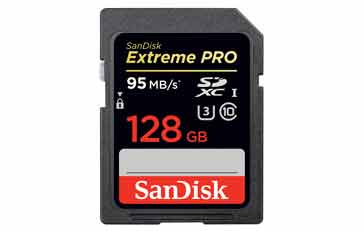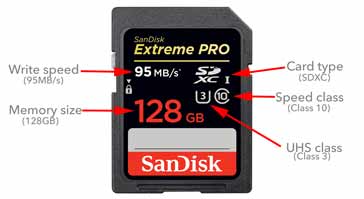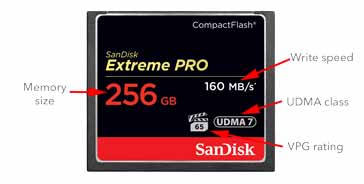Memory Card Buying Guide
Find your way through the maze of different types of memory card and understand which is the best one for your camera, mobile phone, or any of your electronic gadgets using our definitive buying guide.
Flash Memory Tutorial Includes:
What is Flash memory technology
How Flash memory works
Flash lifetime & reliability
Memory card buying guide
Memory types:
Memory types & technologies
DRAM
EEPROM
Flash
FRAM
MRAM
Phase change memory
SDRAM
SRAM
Memory cards are used in everything from cameras to mobile phones as well as a host of other electronic equipment and gadgets.
These memory cards use what is termed Flash technology and store the data even when the power is removed. As such these memory cards have become invaluable for storing everything from photos to Apps and programming data to . . well almost anything.
The big issue with memory cards is being able to select the best one for the particular use or application in mind. There are so many different types.

To help, we have set out our memory card buying guide to help explain some of the major types and what memory card is best for certain applications.
Types of memory card
One of the major sources of confusion is that there are so many different types of memory card on the market to buy. Compact Flash, SD, SDHC, SDXC, MicroSd and more.
Each of these different types of Flash memory card is intended for a different type of application. Some are used for cameras, and often speed can be an issue, especially where video is being taken. Others are used within mobile phones where size is a very important issue. Also there are the USB memory sticks where speed is not normally an issue.
There are so many different types of card, that is is essential to check the exact type being used.
So what types of Flash memory card are there and what is the difference?
- SD memory card: This is the basic format for the SD card. The standard SD card has dimensions of 32 mm by 24 mm by 2.1 mm, a storage capacity of up to 4 GB. Typical levels of performance are not as high as the other types of SD memory card mentioned below.
- SDHC memory card: SDHC (Secure Digital High Capacity) was introduced to meet the growing demand for HD video and high resolution image recording now used in many SD-enabled devices. SDHC cards are the same physical size and shape as standard SD but meets the new SD specification of version 2.0. If the SD card is 4GB or above, it is classed as a SDHC card. Currently, SDHC specifications allow for memory cards of a capacity between 4GB and 32GB. If you are buying an SDHC card, check that the device in which it will be used can accept an SDHC.
- SDXC memory card : SDXC, Secure Digital eXtended Capacity. SDXC cards are essentially a higher capacity version of the SDHC card. SDXC cards start at capacities of 64GB and can grow to a maximum theoretical capacity of 2TB.
- MicroSD memory card : As the name indicates, the microSD memory cards are much smaller than the basic SD card. Accordingly they find many uses in portable equipment like mobile phones.
- microSDHC : microSDHC cards, the newer version of microSD, were introduced in 2007. They can contain up to 32 GB of data and have a transfer rate of up to 10 MB per second. microSDHC cards are not backwards compatible with older microSD devices.
- microSDXC : Like the SDXC card, microSDXC cards have a storage capacity between 32 GB and 2 TB. The card has a faster data transfer speed compared to the microSD and microSDHC. It is only compatible with devices containing a microSDXC-compatible slot.
- Compact Flash card: This type of memory card is physically larger than an SD card and it has many more connections. They are not as commonly used as SD cards, but have often have large capacities and some can run at very high speeds. They are generally used by professional photographers.
These different types of memory card tend to be found in different types of device. A short summary is given below, but remember, this is only a rough guide.
| Typical Memory Card Applications |
|||||
|---|---|---|---|---|---|
| Memory Card/Device | SD | SDHC | SDXC | MicroSD | Compact Flash |
| Mobile Phones | ✔ | ||||
| Digital Cameras | ✔ | ✔ | ✔ | ✔ | |
| Laptop/Computers | ✔ | ✔ | ✔ | ||
| Tablets | ✔ | ||||
| DSLR Cameras | ✔ | ✔ | ✔ | ||
Memory card size
When selecting the best memory card to buy, one of the first points to note is the amount of storage they offer, i.e. the memory size.
The sizes have increased remarkably in recent years. Some years ago size of 1GB would have been large, but nowadays 128 GB is not uncommon.
SD card speed ratings
The speed of the card is important in many applications as it indicates the data transfer speed of the device. This is important when writing data at high speeds as in the case of 4K video, which is becoming more common, even on mobile phones!
On the SD card there are various speed classes. This refers to speed classes for reading and writing images to and from a memory card, expressed as megabytes per second, MB/s. The coding is simple, Class 2 is has a transfer rate of 2 MB/s, Class 4, 4MB/s etc. Classes are generally Class 2, 4, 6, 10.
| SD Memory Card Speed Classes |
|
|---|---|
| Class | Minimum Speed |
| 2 | 2 MB/s |
| 4 | 4 MB/s |
| 6 | 6 MB/s |
| 8 | MB/s | 10 | 10 MB/s |
A further format UHS Speed Class was introduced in 2009 for SDHC and SDXC memory cards. To achieve the higher data rates, the UHS utilizes a new data bus that will not work on non-UHS compatible devices. If a UHS memory card is used in a non-UHS host, it will default to the standard data bus and use the “Speed Class” rating instead of the “UHS Speed Class” rating. UHS Class 1 provides a speed of 10 MB/s and UHS class 3 gives 30MB/s
| SD Memory Card Speed Classes |
|
|---|---|
| UHS Class | Minimum Speed |
| 1 | 10 MB/s |
| 3 | 30 MB/s |
For video recording another speed class is called the V class. This is used primarily for video recording specs.
| SD Memory Card Video Speed Classes |
|
|---|---|
| Class | Minimum Speed |
| V6 | 6 MB/s |
| V10 | 10 MB/s |
| V30 | 30 MB/s |
| V60 | 60 MB/s | V90 | 90 MB/s |

When interpreting all these figures it is worth remembering that the speed rating that might be written on the card itself measures maximum transfer speed for reading and writing images to and from a memory card. This is the figure expressed as NN MB/s.
Unlike card write speeds mentioned in the paragraph above, that measure maximum performance, class ratings measure the minimum sustained speed required for recording an even rate of video onto the card. The class rating number corresponds to the transfer rate measured in MB/s.
Compact Flash speed ratings
As Compact Flash is not under the governance of the SD Association, it has a number of different speed ratings. There are two main types that are seen. Often both on the same card.

- UDMA rating: Ultra direct memory access enables more rapid write and read speeds, allowing the card to support HD and 4K images. Cards are graded from 0-7, with 7 offering the highest performance. Just want the highest speed possible? Be sure that the speed of your device supports the speed of the card, otherwise the benefits are lost.
- VPG: VPG standard for for video performance guarantee and is very similar to the speed class od an SD card. There are two classifications: VPG-20 and VPG-65, with the latter offering the minimum possible risk of frame loss.
Like the SD cards, Compact Flash, CF card may also have a maximum speed in MB/s written on the device.
Choosing best memory card
Having looked at the various specifications and parameters it is necessary to look at what is actually needed when buying a Flash memory card.
The first thing is the size of card. With huge sizes being offered these days, it is necessary first to check what the device in which the card will be used can handle.
The next is to determine what is required in terms of actual storage on the device. Remember that some DSLRs only allow the card to be reformatted or individual images to be deleted, there is no delete all function.
It is useful to look at what can be stored in typical cards:
| Capacity (GB) | Hours of MP3 music | Photos (12MP JPEG format) | Photos (20MP JPEG format) | Photos (20MP RAW format) | Standard HD Video Recording (9Mbps) | Full HD Video Recording (13 Mbps) |
|---|---|---|---|---|---|---|
| 16 | 270 | 3800 | 2660 | 260 | 240mins | 160mins |
| 32 | 545 | 7600 | 5330 | 520 | 480mins | 320mins |
| 64 | 1090 | 15200 | 10660 | 1040 | 960mins | 640mins |
| 128 | 2145 | 30400 | 21320 | 2080 | 1920mins | 1280mins |
When it comes to choosing the best memory card type to buy and the speed for the device to use the memory card it is a little more difficult. The first thing to do is to check what it can use. Whether it will take, SD, SDHC, SDXC? Once this is know then the search can start.
The rated speed measured in MB/s and stated on the card is important mostly for still photography, especially where large files are being written to the card. It is most important when using a multishot burst on a high megapixel DSLR. Here it is often possible to end up with a backlog of images in the camera if it cannot write to the card fast enough. This can result with the camera stopping shooting until it can write to the card and free up more internal space.
Higher speeds can also improve how quickly the files can be transferred to the computer.
However, video not need need as large a data pipe because the video format is a smaller "fixed stream" that uses only a portion of the data pipe. Although for 4k video faster cards are needed as the amount of data transferred is very much bigger.
Looking at the speed class, as this is a minimum speed, this is important for video mode or camcorders, where the device is actually saving a steady stream of data. The resolution and format of the video determines the amount of steady stream data. This translates to a minimum speed needed to guarantee that the video captured on the cards is recorded at an even, sustained rate with no dropped frames. It is necessary to check the specification of the video camera as this will state what is required in terms of the minimum speed class.
It is possible that some advanced video cameras or DSLRs may indicate an error message saying only lower definition video can be recorded if a card with a low speed class is used.
There are many things to consider when selecting the best memory card to buy for any camera, phone or other device requiring a memory card. Selecting the best device to buy needs a few specifications to be considered, but once this is done the device can be inserted and should give long reliable ervice.
 Written by Ian Poole .
Written by Ian Poole .
Experienced electronics engineer and author.
More Electronic Components:
Batteries
Capacitors
Connectors
ADC
DAC
Diodes
FET
Inductors
Memory types
Phototransistor
Quartz crystals
Relays
Resistors
RF connectors
Switches
Surface mount technology
Thyristor
Transformers
Transistor
Unijunction
Valves / Tubes
Return to Components menu . . .




